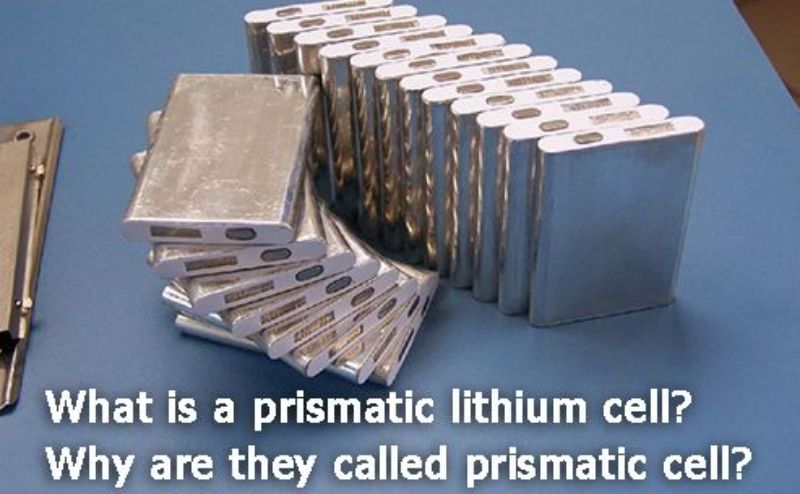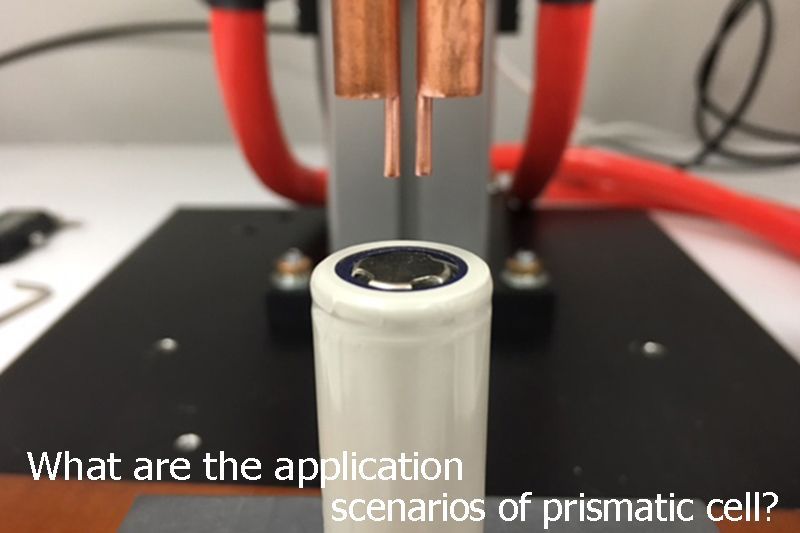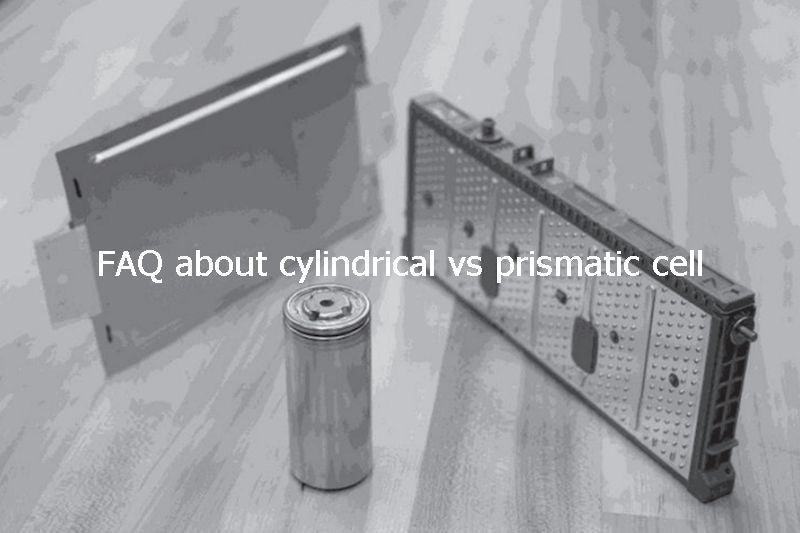
Main content:
You must have heard about lithium cells—the king of battery technology. If you’re looking to switch to lithium batteries, you might be surprised to find out that they are not precisely the same. Lithium battery cells come in different shapes and formats. They can be prismatic, cylindrical, or lipo-battery. Each comes with its unique inner structure, manufacturing process, dimension, and electrode separator. So, what is the difference between these lithium battery cells? Is prismatic cell better?
1.What is a prismatic cell?
Lithium batteries are available in different cell formats and shapes to satisfy every user’s needs. As the demand for lithium cells increased, prismatic cells were born out of this necessity. If you want to know what prismatic lithium cell is, check out your cell phone battery. In addition, there are also many mobile phone batteries with pouch cells. Prismatic cells are positive and negative electrodes packed together in flattened spiral form and contained in a rectangular-shaped casing. These rectangular casings usually have thicker cell walls, while the cells deliver about 25ah-280ah capacity.
2.Why is it called prismatic cell?
Generally, different lithium battery designs are called so due to their structure. Just as you has cylindrical cell with cylinder structures and pouch cell with pouch-like structures, prismatic cell has prismatic shapes. The prismatic shape of these lithium battery cells is an excellent way to optimize packaging efficiency while also reducing weight and cost at the same time. They have a thin profile by design, which makes them a perfect choice for mobile phones and hybrid cars.
3.What is the structure and manufacturing method of prismatic cell?

The prismatic lithium cell consists of anode, cathode and a separator compound in between them, filled with electrolytes, rolled up and pressed into a cube-shaped metal or hard plastic shell.Electrodes can also be assembled by layer stacking instead of jelly rolls.The anode in the prismatic housing could be carbon or graphite or other nanostructured formulations, including germanium particles and crystalline silicon. The cathode end contains the nickel-cobalt-manganese or iron phosphate common in lithium cells. In most cases, the separator compound consists of polypropylene. Prismatic lithium cells are rechargeable batteries, LiClO4 and a mixed organic solvent dissolved in propylene carbonate and dimethoxyethane were used as the electrolyte solution, and lithium ions move between the cathode and the anode as conductive ions. When charging lithium batteries, lithium ions move from the anode end to the cathode end through the electrolyte.
In this type of lithium battery, the cells are stacked in columns, with either single to two-row modules. To manufacture the prismatic body, a metal plate of predetermined thickness is bent and welded together. Then, the upper and bottom seals, which correspond to the shape of the metal plates, are manufactured and welded (welding the bottom portion). After that, the electrode assembly, which comprises cathode and anode interposed by a separator compound, is inserted into the battery case—finally, the upper portion of the case weld to the rest of the casing.
4.What are the application scenarios of prismatic cell?
Prismatic cell is predominantly used in electric vehicles, mobile phones with lithium-ion, medical fields, communication-based stations, etc.

5.Does Tesla use prismatic cell?
No, Tesla is currently using “advanced” cylindrical battery cells. While some EV makers adopt prismatic and pouch cells, Tesla’s “advanced” cylindrical cells give it an edge over other EV makers as its cylindrical batteries offer a more extended drive range and pose a lesser risk of exploding. However, Tesla is looking to explore the prismatic battery cell alternative. About two years ago, the EV maker announced that its Model 3 cars in China would soon adopt prismatic battery cells for the first time. The Tesla Model 3 in China will come with CATL lithium-iron-phosphate (LFP) batteries, which will be prismatic.
6.FAQ about cylindrical vs. prismatic cell

① What are cylindrical cells?
Cylindrical batteries are one of the most popular lithium batteries, thanks to their low cost and extended battery life, their cylinder design makes them with good cycle capacity ,long life and good cost performance. They consist of anodes, cathodes electrolyte and separators rolled and packaged in cylindrical cans.
② What is the difference between cylindrical and prismatic cells?
Prismatic and cylindrical cells are one of the most commonly used lithium battery cells. While cylindrical cell us cylindrical, prismatic cell is packed in rectangular-shaped can. Cylindrical cell is less expensive to manufacture than prismatic cell and can withstand internal pressure without swelling up. It is also relatively cheaper than prismatic cell and is mostly useful in medical instruments, laptop batteries, electric tools and other applications in a wide variety of application scenarios. However, they use up more space than necessary and are not so efficient. Prismatic cell on the other end can save space when the pack is formed into a battery pack. However, they are more expensive and they have poorer thermal stability and lower heat dissipation efficiency. When the internal pressure is high, the prismatic cell is prone to deformation, safety performance is not high as cylindrical batteries, and is shorter than the cylindrical design cycle life. Also, damage in one cell will affect the whole cell. But on the brighter side, they have higher space utilization and energy storage capacity than cylindrical batteries. They are also an excellent option for high-power applications, thanks to their large capacity.
③ Can prismatic cells replace cylindrical cells?
No, prismatic cell can’t replace cylindrical cell. Their difference in designs alone makes a case for their applications to be different. Compared with the cylindrical design, prismatic cell need a slightly thick support plate to make up for the mechanical stability weakness. Also, the expensive nature of prismatic cell, will make it harder for them to replace each other.
7.FAQ about pouch vs. prismatic cell

① What is pouch cell?
Pouch cells are another type of lithium battery cell. Besides the shape and packaging material, which has simple structure, flexible, and light quality there’s hardly much to differentiate this type of lithium cell from other cell types—cylindrical and prismatic cells. In pouch cells, the electrode assembly and the separator are in an aluminium-plastic film. This packaging style means reduced weight and makes this lithium cell more flexible, effortlessly adapting to different products.
② What is the difference between a pouch and prismatic cells?
Like prismatic cells, pouch cells are highly efficient for the space. However, pouch cells have a higher space utilization rate, its packaging utilization rate is up to 90% -95%, which is the highest utilization rate of all battery packaging methods. While the cells are arranged in series, making it possible for easy discharge and recharge, pouch cells are flat, laminated, and folded to pouch-like shapes. They also don’t explode easily or cause fire like prismatic batteries. Pouch batteries are also cheaper than prismatic cells and have higher energy density. However, prismatic batteries has a slightly higher durability and a longer cycle lifespan.
③ Is prismatic cell better?
One of the major reasons for the increasing rise in the adaptation of prismatic cell is its higher energy capacity. Their thinner shape also makes it very easy for a broader use case. However, they have some notable downsides, including shorter cycle life and slightly worse thermal stability compared to cylindrical cells. Each type of battery has its own suitable application scenarios,According to the characteristics of the prismatic battery, by applying it to the appropriate scene, it will be the best choice. Finally, pouch, cylindrical battery and prismatic lithium cell all have their strengths and weaknesses, affecting their application. If you want to go for prismatic cell, always ensure you’re applying it to a suitable device.